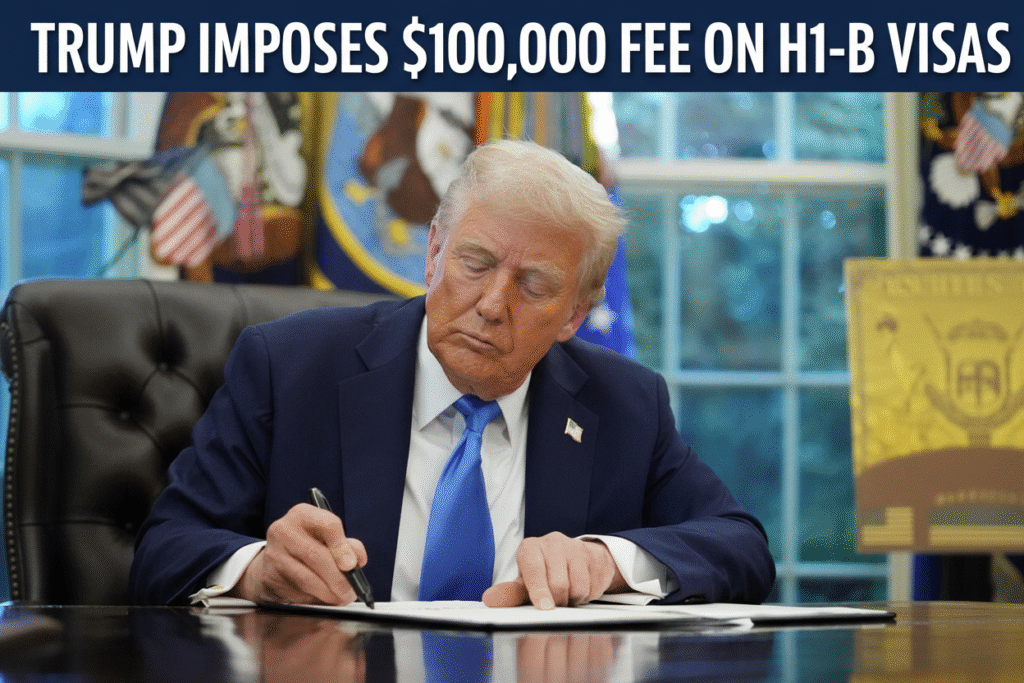US President Donald Trump announces a $100,000 annual fee on H1-B visas, sparking concerns for Indian IT professionals. The move aims to protect American jobs while reshaping immigration policy.
Trump’s New Order Shakes Up H1-B Visa System
In a sweeping immigration move, US President Donald Trump has announced a staggering $100,000 annual fee on H1-B visas. The decision, signed at the White House on Friday, marks one of the sharpest escalations in the administration’s effort to curb foreign work visas.

The proclamation is expected to significantly impact Indian tech professionals, who form the largest share of H1-B holders in the United States. For companies, the hike means paying an additional $100,000 per sponsored worker every year—making the programme far costlier than ever before.
White House: “End to Visa Abuse”
White House staff secretary Will Scharf defended the move, calling the H1-B system “one of the most abused visa programmes.” He stressed that the new fee would ensure only “truly extraordinary” talent makes it to the US job market.
“Either the person is very valuable to the company and America, or they’re going to depart and the company is going to hire an American. That’s the point,” Scharf said.
The Trump administration argues that the measure will safeguard American jobs while bringing billions of dollars into the US Treasury.
Impact on Indian Workers and Tech Giants
For Indian professionals, the change could prove devastating. H1-B visas, valid for up to six years, have long been a lifeline for skilled workers in the IT and tech industry. But with the new fee structure, many US-based companies may hesitate to retain foreign workers, especially those stuck in the long green card backlog.
Analysts warn that Indian IT firms, outsourcing companies, and Silicon Valley tech giants may now rethink their hiring strategies. The steep annual fee could make it economically unviable to sponsor foreign workers compared to hiring fresh American graduates.
The Gold Card: A New Visa Pathway
Alongside the H1-B changes, Trump also unveiled a new “Gold Card Visa” programme. Under this scheme, individuals who contribute $1 million (or $2 million if sponsored by a corporation) to the US Treasury will gain access to an expedited visa and a pathway to permanent residency.
Trump hailed the initiative as a win-win, promising that it would raise “hundreds of billions of dollars” while allowing companies to retain top-tier global talent.
“Companies Love It,” Says Trump
Despite concerns, Trump insisted that US companies back the move. “They love it. They need it. The main thing is, we’re going to have great people coming in,” he said in the Oval Office while signing the order.
Commerce Secretary Howard Lutnick supported the policy, claiming that earlier visa programmes had disproportionately admitted workers earning below-average wages. “We’re going to stop doing that. We’re going to only take extraordinary people at the very top,” he said.
Key Highlights of H1-B Visas
- $100,000 annual fee imposed on all H1-B visas, including renewals.
- Move expected to hit Indian tech workers hardest, with companies reassessing sponsorships.
- New Gold Card visa offers fast-track residency for those investing $1–2 million.
- Administration claims the measures will raise billions and protect American jobs.
The Trump administration’s latest order marks a historic turning point in US immigration policy. While the White House touts the move as a step to protect American workers, its real-world impact could be severe for thousands of Indian professionals and the tech firms that depend on them.
The coming months will reveal whether companies are willing to bear the $100,000 annual price tag to retain their foreign talent—or if this signals a shift toward a drastically different hiring landscape in the United States.
